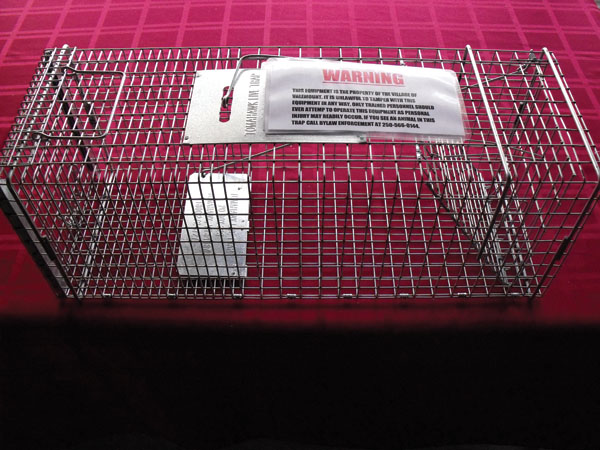
Stray cats urinating in flower beds and under motorcycle covers.
These are some of the stories heard by Valemount’s bylaw enforcement officer Erik Myggland among a dozen ongoing complaints about stray cats roaming the village.
“A lot of people are getting quite upset about it to the point where they’re starting to take matters into their own hands,” he says.
Myggland says a stray cat was recently treated by the veterinarian after it was shot with a BB gun.
“The animal’s very safety is at stake at this point,” he says. “It’s better if we capture them and find them a home.”
He says he has received complaints from homeowners who have litters of cats living underneath their homes. The Hartman’s trailer court is one location in town with a thriving colony., he says.
“You drive through there and you have kittens scattering like cockroaches.”
Dee McEachern lives in the Hartman’s trailer park and says people come to the trailer park each day to feed the half-dozen strays that live near her home. The most recent batch of kittens often huddles under her porch. There are a dozen or so feral cats living at the trailer park and three generations so far – a litter last year and another this past spring, she says. The adult male was neutered recently.
But McEachern says the cats haven’t been a problem so far – and they keep the mice down.
“I’m not sure who they’re really a problem for,” she says.

Problems in Tete-Jaune
Local resident and animal rescuer Chris Dolbec says the problem in Tete-Jaune has gotten far out of hand. There are at least a hundred feral cats living at one residence and while they are being fed, they are suffering from disease and are bait for cougars and coyotes.
“I think there’s definitely an increase in the coyote population. It’s an easy free-for-all.”
The feral cat problem stems from one residence in particular, but has spread to several more.
Dolbec herself has taken in a litter of kittens and has since found homes for them. She already has six cats and two dogs of her own. She says the diseased cats and kittens also pose a threat to domestic pets who could catch the same diseases.
The colony is growing rapidly and has been an ongoing problem for five or six years, she says.
“It’s a bad situation. It should have never been left for so long,” she says. “People say that they’re thriving and the problem is you only see the ones that are healthy you don’t see the ones that are sick.”
She says she would like to blame the situation on ignorance and being uneducated, but a lot of the people she knows in this situation are well educated and they can afford to fix the animals, but they choose not to.
It becomes not just an animal health concern, but a human one too.
“I’ve gone into hoarding situations and I know what it’s like to have your gumboots sucked off in ankle-deep feces in people’s homes and they don’t see anything wrong with it.”
Charleen Holloway, Branch Manager of the Kamloops SPCA says they become involved in hoarding situations if cruelty to the animal is in issue, where they lack food, space, water, or medical attention. If that is the case, they would go in and investigate. She says they do travel to rural areas to investigate complaints.
“Maybe the person just requires a little support. At other times we need to go in with warrants.”
She says some pet owners don’t believe in spay and neutering or they think of themselves as a rescue service. Pet owners need to be prepared to spay or neuter their animals when they acquire them, she says.
Dolbec agrees: “The only balls your cats or dogs need are the ones they chase.”
Jurisdictional issues
Myggland is only responsible for complaints within village limits, but some problems lay on the other side of the village boundaries.
He says they had problems with animals on 17th avenue, which is outside the Village. The complaints were so bad that Myggland alerted the RCMP to help deal with the issue.
People living outside the Village have fewer options when it comes to strays. Myggland says they can call the Regional District of Fraser Fort George bylaw compliance department or Prince George SPCA, unless the situation becomes a police matter.
“I’ll do whatever I have to, to get control of the situation. If the traps don’t work I’ll get a tranquilizer gun. I’ll do whatever I can to trap them and find them a good home.”
The Valemount pound is located at the Village Compound near the old Village Office close to Gorse Street.
The new animal control bylaw outlining local by-laws for pets can be viewed at the village office or by clicking here



